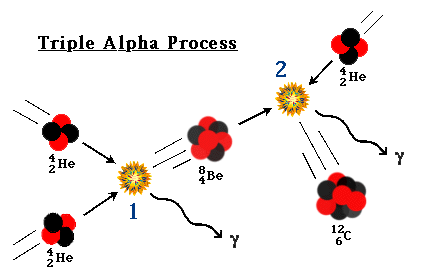Como é que as estrelas consomem hélio?
Uma estrela com menos de 5 massas solares acaba por atingir eventualmente uma fase em que todo o Hidrogénio da zona central foi convertido em Hélio (ver Pergunta 76). A temperatura no centro da estrela não é ainda suficiente para que ocorra a fusão nuclear do Hélio. A camada externa da estrela é ainda composta por Hidrogénio mas aqui a temperatura já não é suficiente para que continue a ocorrer a fusão nuclear do Hidrogénio em Hélio.
A região central da estrela acaba por se contrair convertendo, assim, energia potencial gravitica em energia cinética. Como resultado o núcleo da estrela aquece o mesmo acontecendo com a camada de Hidrogénio que o circunda. Voltamos a ter fusão nuclear do Hidrogénio em Hélio. Como resultado as camadas mais externas da estrela expandem dando origem a uma gigante vermelha.
A região central da estrela, que estava em contração gravítica, acaba por atingir uma temperatura suficiente (cerca de 100 milhões de ºC) para que tenham início as reações de fusão nuclear do Hélio em Carbono. Nesta fase o Hélio está no estado degenerado (todos os electrões ocupam o estado de energia mais baixo permitido) o que faz com que a conversão Hélio-Carbono seja muito rápida e violenta. É o chamado flash do Hélio que tem como consequência um breve aumento na luminosidade da estrela. A temperatura do núcleo da estrela aumenta o que faz com que o Hélio deixe de estar no estado degenerado. A partir desse momento a combustão nuclear do Hélio ocorre de forma estável.
No caso das estrelas de maior masssa a temperatura necessária para que ocorra a fusão nuclear do Hélio é atingida antes deste se tornar degenerado. Assim, neste caso, a fusão nuclear do Hélio começa logo de forma estável.

Esquema do processo triplo-alfa da fusão nuclear do Hélio em Carbono / Sketch of the process of the triple-alfa fusion of Helium into Carbon.
(http://aether.lbl.gov/www/tour/elements/stellar/3alpha.gif)
How do stars consume Helium?
A star with less than 5 solar masses eventually reaches
a phase where all the Hydrogen in its central region has been converted into
Helium (see
Question 76).
The temperature at the centre of the star is still not high enough for nuclear
fusion Helium to occur. The external layer of the star is made up of Hydrogen
but here the temperature is not high enough for the nuclear fusion of Hydrogen
into Helium to occur.
The central region of the star ends up contracting,
thus, converting the gravitational potential energy into kinetic energy. As a
result the nucleus of the star heats up and the same happens to the layer of
Hydrogen that surrounds it. We again get nuclear fusion into Helium.
As a result the more external layers of the star expand
giving origin to a red giant.
The central region of the star, that was in
gravitational contraction, reaches a high enough temperature (about 100 million
degree celcius) for the nuclear reactions of Helium into Carbon to start
occuring. In this phase the Helium is in a degenerated state (all the electrons
occupy the lowest energy level that is permitted) which leads to the conversion
Helium-Carbon to be much faster and violent. This is the so called
Helium flash that hás as a consequence a brief increase in the stars
luminosity. The temperature of the stars nucleus increases which leads to the
Helium leaving the degenerated state. After this moment the nuclear combustion
of Helium occurs in a stable manner.
In the case of stars with higher masses the temperature
needed for nuclear fusion of Helium to occur is reached before it become
degenerated. In this case the nuclear fusion of Helium starts immediately in the
stable state.
